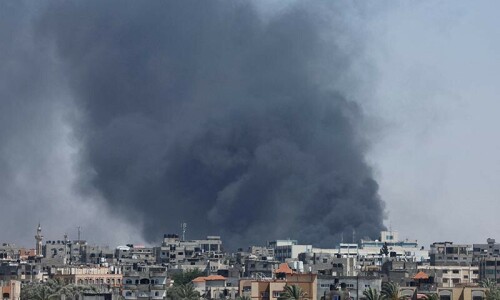Arich tapestry of textural paint applications and specific symbolist vocabulary emerged as the defining features of Saqib Mughul’s exhibition, ‘Darvazey’, shown at Koel Gallery, Karachi, recently. Essentially mix media exercises, the canvas surfaces, literally constructed/painted with pigment treatments, carried small templates/stencils of antiquated doors as heritage markers. By bringing an archaic eastern object in conversation with a western painterly sensibility the artist opted for a contemporary dialogue on issues related to tradition and modernity.
After graduating from the Karachi School of Art in 1997, Mughal established himself as an artist in Karachi. In 1999 he moved to the United States to further his career as a creative director and painter. On completing his visual art education in the US, he joined American art circles and currently works and lives in Miami, Florida. He has held several solo and group shows in both countries.
As a migrant artist Moghul’s art carries imprints of two diverse cultural environments. A childhood affiliation with his country of origin and later life association with his host country has enabled him to experience reality from diverse perspectives. Locating his work in a third space, a broader platform of universal values he voices his desires and aspirations that relate to new comprehensions and realisations.
The door/Darvazey symbol is his gateway to ‘here and there’ and everywhere and to facilitate this freedom to take flight, to imagine, dream and fantasise, he introduces the butterfly emblem as the other significant character in his aesthetic vocabulary. According to him, “The door symbol signifies ‘closed’ or ‘way to get out’. The butterfly implies change, innocence and freedom. Textures of old walls symbolise home.”
Transcending boundaries, the kind of closures inanimate doors can imply, on the wings of fleeting, mythic butterflies implies wondrous flights of imagination. But Mughul’s winged creatures are anchored to his oriental doors/Darvazey which are almost always closed and remain suspended in a dense network of closely configured strokes. The transition implied by the artist appears opaque and ponderous as if weighed down with the gravity of his reasoning. The embellished butterfly images are attractive, exotic and ornamental but remain motionless. As striking appendages they spotlight the door facades which emerge more as emblems of a glorious past than as portals of dynamic change.
The other striking feature of Mughal’s current show is his consistent focus on surface treatments in his paintings. Investigating the potentials inherent within the painting medium itself he manipulates the physicality of pigments to create an intriguing new range of textural surfaces. His canvases carpeted with a trajectory of linear encrusted effects stake their claim as an emotive expression. Minutely grafted in multiple colours or elegantly woven in monotone the textural and chromatic mixes ground him as a painter who is immersed in the process of painting.
For most Modernist painters the processes involved in the painting are of greater certainty and of greater meaning than the referential aspects of the painting and Moghul’s close engagement with materials also aligns with this stance. In most paintings his chromatic and textural ploys are dominant while his conceptual triggers take a backseat.
Moving away from cluttered, complex conceptual compositions and a plethora of mixed media effects common to his exhibitions in the recent past Moghul has opted for simplified form and content in this show. This quiet and concentrated focus has brought considerable maturity to his expression and a distinct direction is now visible in his thoughts and working skills. This intensity is also a positive indicator of his inherent potential.
Exhibitions of migrant artists were once few and far between but with the rising profile of Pakistani art abroad the trend has changed. Artists in Diaspora are exhibiting much more frequently on home ground now and there should be a greater keenness to reclaim this brain drain. Their broader perspective, almost always carrying some reference to their initial homeland, adds more dimensions to the scale of Pakistani art. In this regard Moghul feels, “Living abroad and viewing turmoil in Pakistan creates complex feelings but distance does help one to put matters into perspective.”












































Dear visitor, the comments section is undergoing an overhaul and will return soon.